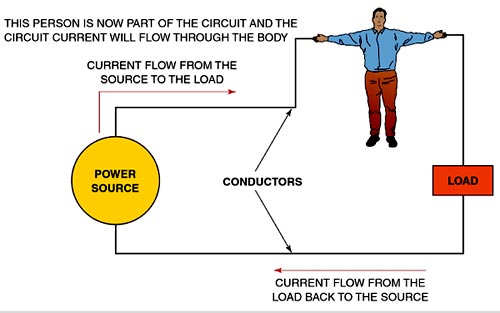At what level of current flow during electric shock death is possible
Right Answer is:
50 to 100 milli-amp
SOLUTION
Electric Shock Hazards
Injuries related to electrical shocks are common accidents occurring every year and everywhere, especially when it comes to occupational incidents. Most workplaces nowadays are equipped with an electrical source and open electrical equipment that may expose workers to the hazard of being electrocuted.
Electricity refers to the flow of electrons through a material. The force that drives the electrons and makes electron flow possible is known as the voltage. Any material or substance through which electricity flows is called a conductor. Examples of conductors used in electrical work include copper and aluminum. These substances offer very little resistance to electron flow. Some materials offer very high resistance to electron flow and are classified as insulators. Examples are plastic, rubber, and porcelain. Electricity flows along a path or circuit. Typically, this path begins with a power source and follows through a conductor to a load. The path then flows back along another conductor to the Power source.

A very important point to consider at this time is that the human body can, under certain conditions, readily become a conductor and a part of the electrical circuit. When this happens, the result is often fatal. Electrons flowing in the circuit have no way of detecting the difference between human beings and electrical equipment.
The resistance of the Human dry skin is about 100,000 Ohms to 500,000 ohms, during the perspiring or sweaty hand the resistance becomes 1000 ohms. While when the body is completely wet or under the water the resistance drops down to 150 ohms.
The human body reacts differently to the level of current flowing through it. The data shows some typical reactions when a body is subjected to various amounts of current Remember that a milliampere (mA) is 1/1000 (0.001) of an ampere. It is a very small amount of current.
⇒ Less than 1mA = No Sensation
⇒ 1 mA = Possibly a tingling sensation
⇒ 5 mA = Slight shock felt; not painful, but disturbing; most people can let go; strong involuntary reactions may lead to injuries
⇒ 6 to 30 mA = Can definitely feel the shock; it may be painful and you could experience muscular contraction (which could cause you to hold on)
⇒ 50 to 150 mA = Painful shock, breathing could stop, severe muscle contractions; death is possible.
⇒ 1000 to 4300 mA = Heart convulsions (ventricular fibrillation), paralysis of breathing; usually means death
⇒ 10,000 mA = Cardiac arrest and severe burn deathly
| Current range | Effect |
| 0.5-2 mA | Threshold of sensation |
| 10-15 mA | Involuntary muscle contractions, cannot release contact |
| 15-100 mA | Severe shock, muscle control lost, breathing difficult |
| 100-200 mA | Fibrillation of the heart, death within minutes |
| >200 mA | Severe burns: cardiac arrest: breathing stops |
